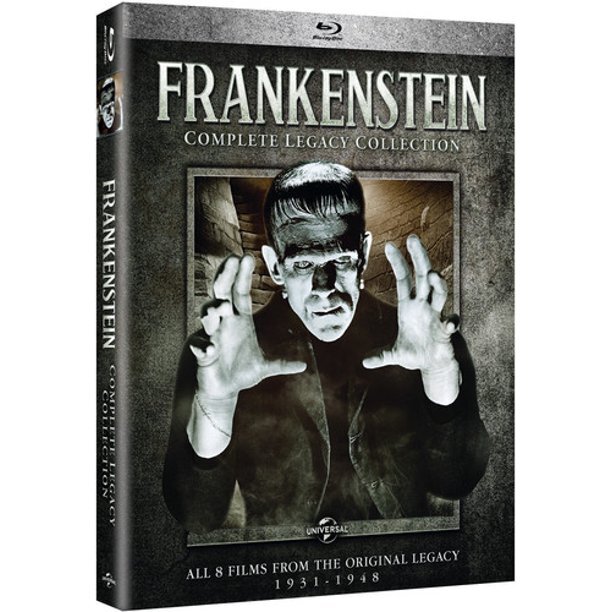This is a blog series about … well, series. I love stories that continue across volumes, in whatever form: linked short stories, novels, novellas, television, movies, comics.
The Frankenstein novels (3 volumes)
Written by Frank Schildiner
published by Black Coat Press (2015 – 2019)
Titles:
· The Quest of Frankenstein (2015)
· The Triumph of Frankenstein (2017)
· The Spells of Frankenstein (2019)
Mary Shelley’s classic creation Frankenstein has spawned more sequels and reinterpretations than I have the energy to count at the moment. Back in 1957-58, French screenwriter Jean-Claude Carrière wrote a series of novels featuring Frankenstein’s Monster, now named Gouroull and traveling the world following an agenda of his own making. Gouroull has utter disdain for humanity as a whole and is as likely to murder temporary allies as he is enemies. I’ve never read the Carrière novels (English translations appear to be out of print and highly priced on the secondary market), but I have read Frank Schildiner’s three sequels published by Black Coat Press, which are the subject of today’s post.
Frank Schildiner is a wonderful “new pulp” author whose work runs from pulp adventure (The New Adventures of Thunder Jim Wade) to sword-and-sorcery (The Warrior’s Pilgrimage) to espionage (The Klaus Protocol) to westerns, science fiction, and horror. Much of his work mixes genres, and the Frankenstein novels are no exception. Primarily horror, the books also include elements of classic pulp adventure (scientific or occult investigator type characters) and espionage thrillers (the political machinations of the fictional South American country in which The Triumph of Frankenstein takes place).
Gouroull himself is a far cry from the sympathetic Monster of Shelley’s original novel (who simply wanted to understand his place in the world and have a mate to love) and the childlike force of nature of the early Universal Studios films. If any connection/comparison is to be made, I’d say the Monster as played by Bela Lugosi (when evil hunchback Ygor’s brain had been transplanted into the Monster’s body) comes closest tonally to Carrière/Schildiner’s Gouroull. But where Lugosi’s Monster simply had the potential to be a Force of Evil, Gouroull IS that force. We are meant to be afraid of a creature made by Man but unaffected by human emotions of love and want. Gouroull’s search for someone capable of creating him a Mate is powered by the biological imperative to propagate the species as much as by his disdain for weaker/lesser humanity – there’s not a speck of sentiment or loneliness to be seen. This makes Gouroull a hard character to sympathize with – which is not the same as making him a hard character to root for.
On the contrary, throughout the three books I found myself mostly wanting Gouroull to succeed, mostly because the other characters he encounters and does battle with are even less friendly/sympathetic. (I say “mostly” only because Gouroull’s quest in The Spells of Frankenstein involves bringing the Elder Gods of the Lovecraft Mythos back to Earth, and I mean really, who wants that mission to succeed?) Gouroull does battle with vampires (including but not limited to several “soul clones” of Dracula), sorcerers, necromancers, ghosts, mad scientists (paging Doctors Herbert West and Elizabeth Frankenstein) and other supernatural menaces, but even the theoretically heroic characters he meets (monster hunters named Hezekiah Whately and Martin Mars) are reprehensible, highlighting the worst in human greed and hubris. It’s a pleasure to see characters like these get their come-uppance against a force of nature they cannot overcome.
Even though Gouroull is the focus of each book, these are very much ensemble cast novels. Chapters switch between various characters’ points of view as they are drawn into contact with the Monster, and we get insight into who they are before they encounter in (and why they’re searching for him, when they are) as well as how their encounter changes them (when they survive, that is). It’s an effective way to build tension in each book, but is particularly effective in The Spells of Frankenstein, where we meet a pair of heroic human characters of Schildiner’s creation who I would love to see more of in their own books/stories: the Muslim adventurers Faisal and Fatimah. (To a lesser extent, I was also intrigued by Moraika, the tribal wise woman/shamaness Schildiner created for a sub-plot in Triumph and would like to see her plotline continued as well.)
As is the wont of many “new pulp” writers, Schildiner tosses “easter eggs” liberally throughout these books – nods at classic horror and adventure literary and movie characters. And he does it in ways that don’t distract from the on-going narrative. If you know who is being referenced, great. If not, you can always check the author’s notes at the end of each book. I found those notes inspiring interest in a long list of books I’ve not yet read and movies I’ve not yet seen, especially where the nods were in the form of pastiche or homage rather than outright use of a character.
It’s rare these days for an author to write a series in which the books can be read in any order. Like Seanan McGuire’s Wayward Children series, Frank Schildiner’s Frankenstein books each stand alone, complete unto themselves while still having an obvious place in the overall structure of the series. Read the series in publication order (as I did) or in character chronology order (or, I guess, if you’re one of the lucky folks who have the Carrière novels, read Schildiner’s books where they take place within that chronology), whichever fits your fancy.
There may or may not be further Gouroull novels by Schildiner and Black Coat Press. If there are, I look forward to which gaps in the character’s history Schildiner fills in next. If there aren’t, these books together still tell a trio of tales about a version of Frankenstein’s Monster that is not sympathetic but is compelling.

